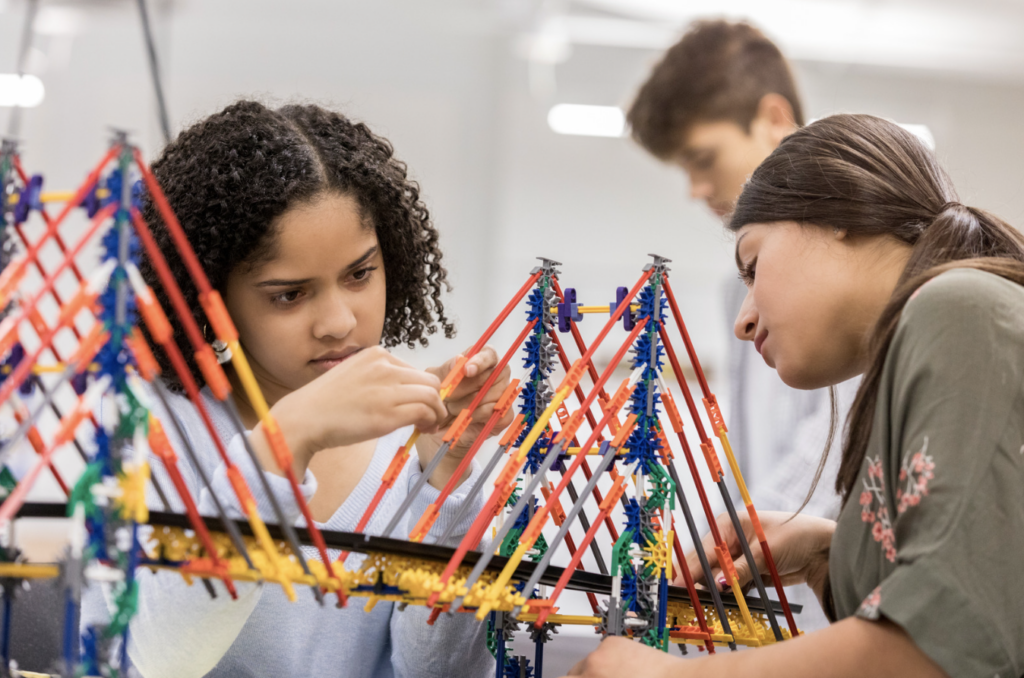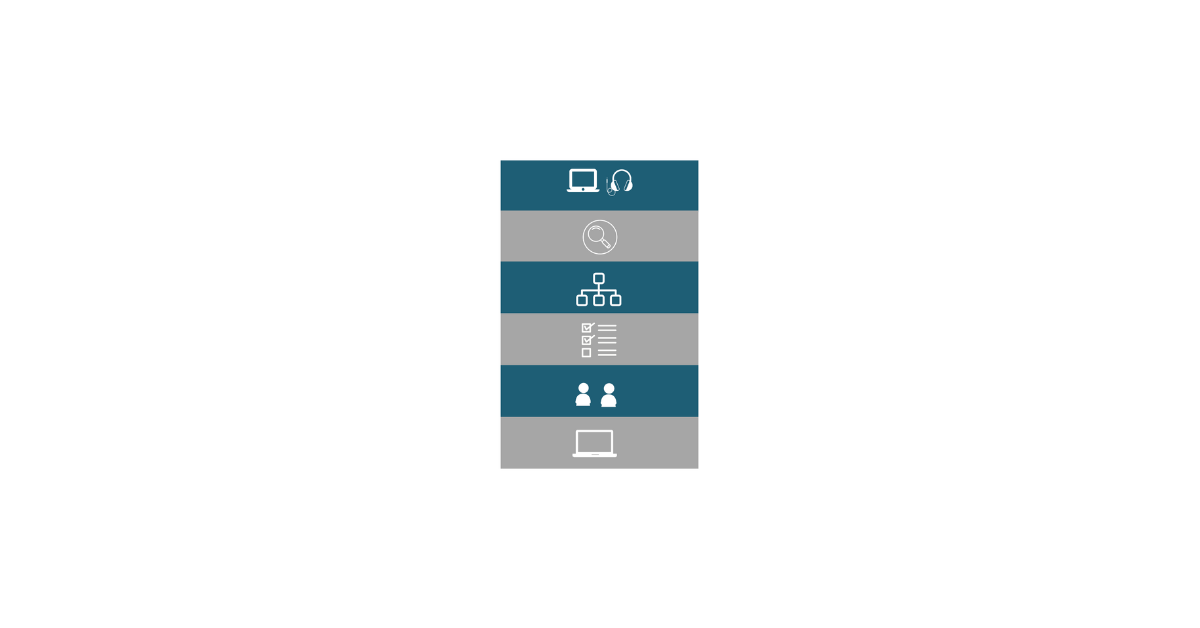Let’s start with a quick review of the playlist, or individual rotation, model for those who have not heard of it. A playlist is a sequence of learning activities designed to move students toward a desired result. Most playlists culminate in a performance task or artifact that demonstrates students’ ability to transfer or apply what they learned working through the playlist.
I’ve trained many teachers who use choice boards and ask, “What’s the difference between a choice board and a playlist?” I wrote a blog about the difference, but here is a quick comparison that might help. A playlist functions like a Spotify music playlist that you cannot shuffle. You listen to a sequence of songs in a particular order. In contrast, a choice board is like ordering off a menu at a restaurant. You select specific items for your appetizer, main dish, and dessert, but there are many things on the menu that you do not eat.
Reason #1: Give Students Control Over Their Pacing
Students acquire and process information at varying rates, naturally leading to a need for different amounts of time to complete academic tasks effectively. Despite this reality, most learning is teacher-paced, not student-paced. The focus is on the teacher covering content and moving students through lessons on a strict timeline. It begs the question, What is the value of racing through material if students don’t understand or retain it?
In a setting where the pace is dictated by the teacher or the curriculum rather than the learner’s needs, students may rush through the material without fully understanding it. The overall quality of students’ work also suffers when they do not have the time and space to fully engage with academic tasks or produce artifacts to express and communicate their learning.

So, teachers who want to leverage the playlist model to give students more control over their learning pace must identify tasks that take students dramatically different amounts of time to compete. Below is a list of academic assignments that benefit from variable time on task.
- Complex Problem Solving: Tasks that involve higher-order thinking and problem-solving, such as math word problems, scientific experiments, or coding projects, often require different amounts of time for students to analyze, understand, and solve.
- Research Projects: When students engage in research projects, they need time to gather information, synthesize their findings, and put together presentations or reports to share their findings. The depth and breadth of research can vary greatly among students, benefiting from a flexible timeline.
- Writing Assignments: Writing tasks, whether creative stories, essays, or research papers, require students to think critically, organize their thoughts, write a draft, and revise based on feedback. These cognitively challenging tasks will require more time for some students.
- Reading Comprehension: Reading assignments, especially those involving complex texts, can take students varying amounts of time to understand and analyze. Students benefit from the freedom to read at their own pace, ensuring they fully comprehend the material before moving on.
- Art Projects: In the visual arts, students often work on projects that require creativity, experimentation, and refinement. These processes cannot be rushed, and allowing variable time ensures students can produce their best work.
- Learning a Language: Acquiring a new language involves mastering vocabulary, grammar, pronunciation, and cultural nuances. Each student progresses differently based on prior knowledge, learning preferences, and exposure to the language.
- Science Labs and Experiments: Scientific inquiry and experimentation involve forming hypotheses, conducting experiments, collecting data, and drawing conclusions. These steps can vary widely in duration among students, depending on their familiarity with the methods and concepts involved.
- Group Projects: When students work in groups, they need to coordinate efforts, communicate effectively, and work collaboratively on a shared task. Some groups will work more quickly, while others will benefit from having more time.
Any of these learning activities or tasks above would benefit from students controlling the pace of their progress and could benefit from the playlist model. I’ve built project playlists, close-reading playlists, and writing playlists. I’ve even constructed entire units of study in a playlist to allow students to move through it at a pace that works for them. To read more about supporting self-paced learning and keeping students on track, check out my blog titled “The Art of Self-Pacing: How to Build Playlists that Keep Students on Track.”
Reason #2: Free Teachers to Work with Individual and Small Groups of Students
The playlist model allows teachers to delegate the delivery of basic information to videos and other multimedia resources, freeing them to concentrate on personalized and differentiated instruction. As a result, teachers can use their class time more effectively, working directly with individual students or small groups who need additional instruction, support, or scaffolding. This also teaches students to hone their self-directed learning skills as they own more of the responsibility for their learning.

As students work through the playlist, teachers can gather formative assessment data to identify those who might benefit most from one-on-one attention. This process ensures that teachers can provide targeted assistance, address specific needs, and ensure that all students are making progress toward the desired result.
Teachers can use this one-on-one or small group time for various tasks.
- Targeted Skill Development: Focus on specific skills that individual students or groups need to develop, guiding practice and providing feedback.
- Concept Reinforcement: Review and reinforce challenging concepts, using different explanations and examples to aid understanding.
- Reading Support: Provide additional reading support, such as guided reading sessions, to help improve comprehension and develop their active reading strategies.
- Writing Workshops: Conduct writing workshops that focus on specific aspects of writing, such as thesis development, paragraph structure, or editing and revising.
- Math Problem Solving: Work through complex math problems together, modeling problem-solving strategies, and discussing different approaches to find solutions.
- Project Guidance: Offer guidance and support on projects, helping students to plan, research, and execute their ideas effectively.
- Language Practice: Engage students in conversation practice, pronunciation exercises, or grammar activities.
- Feedback Sessions: Provide detailed, processed-based feedback on students’ work, highlighting strengths, identifying areas for improvement, and suggesting different strategies.
- Study and Organization Skills: Teach study strategies, note-taking, and organizational skills to help students manage their time and learning more effectively.
In these focused sessions, teachers can assess and monitor each student’s progress through the playlist, making real-time adjustments or additions to their learning path. This flexible approach helps to ensure that all students get what they need to be successful.
Reason #3: Combat Unproductive Behaviors in Class
The playlist model can significantly improve classroom management by addressing the root causes of unproductive behaviors, which often stem from a misalignment between the pace at which a lesson or learning experience is moving and the pace at which students need it to move. When the pace of the class is too fast, students can become overwhelmed, leading to frustration. They may feel like their needs as a learner are not important, which can cause resentment and feelings of apathy. If the pace is too slow, students might become bored and disengage. The playlist model can mitigate or eliminate many of these unproductive behaviors by allowing students to progress through the material at their own pace.

Many classroom behavior issues arise from students feeling left behind or unchallenged. With a self-paced learning model, students are more likely to be absorbed in tasks that match their skill level, reducing disruptive or off-task behavior.
By allowing students to work at their own pace, the playlist model keeps them continuously engaged in tasks that are neither too challenging nor too easy. This sustained engagement helps maintain their interest and motivation in the learning process. Engaged students working on tasks at the right level of difficulty are more likely to understand and retain information, leading to improved academic performance.
Setting the Stage for Successful Classroom Management When Using the Playlist Model.
- The “Why” or Purpose: Explain the value or purpose of this model to students, highlighting the opportunity for self-paced progress and time to work directly with the teacher.
- Class Agreements: Engage the class in a conversation about what behaviors will help to keep the classroom safe, supportive, and productive as students work through a playlist.
- Classroom Environment: Designate specific spaces in the classroom where students can collect offline materials to complete tasks (e.g., supplies station) or collaborate with peers as key moments in the playlist (e.g., conversation corner).
- Expectations for Using the Space: Make sure expectations for moving around the space and keeping things tidy are clear before students begin self-pacing through a playlist.
- Tracking Progress: Select a tracking system (public or private) to keep track of where students are in their progress through the playlist.
- Will this be a public tracker in the classroom where students move their names to the activity where they end their work each day? Or will you use a private digital online tracking system?
- Peer-to-Peer Learning: Incorporate collaborative and social learning opportunities (e.g., reciprocal teaching with multimedia and small group discussions) into your playlists so students can take a break from the screen and work together.
- Metacognitive Skill Building: Ask students to set an academic and behavioral goal for themselves at the start of their work on a playlist and integrate regular opportunities for them to assess the quality of their work and reflect on their progress through the playlist.
Teachers who take the time to set the stage for work on a playlist will find that students are more successful at directing their learning as they move through the playlist.
Wrap Up
The playlist model is an effective instructional model that gives students more control over the pace and path of their learning while ensuring they have access to personalized instruction and support. As a result, this model can reduce frustration, keep students engaged, and minimize unproductive behavior.
Ultimately, the playlist model creates a more inclusive and engaging learning environment. It encourages students to take control of their learning, boosting their confidence and motivation. At the same time, it enables teachers to embrace their role as facilitators of learning, guiding students through a learning path that best suits their individual needs.
Check Out My Other Blogs on The Playlist Model
The Art of Self-Pacing: How to Build Playlists that Keep Students on Track
Playlists vs. Choice Boards: What is the difference?
Blended Learning: Building a Playlist
Playlists: A Path to Personalizing Learning



2 Responses
Hi Dr. Tucker,
I’ve been doing Choice Boards for years and I’ve always felt like something was lacking in them—that students were not gaining complete understanding of all the concepts. Students tend to make the same choices on the Choice Boards because they assumed it was easier to complete or required less work, or the concept was an easier one to understand. I like the Playlist model. By providing them with multiple Playlists to choose from, I could still give them choice and control over their pacing, while also still guiding them on a path to achieve their learning goal. I wish I used the Playlist model when I was still teaching.
Take care, and see you June 12 for the Blended Learning Mini Conference!
Thanks for sharing your experience with choice boards! I’ve heard other educators express the same concerns about the choices students make. I like to embed “would you rather” choices into my playlists too. That way, they have different ways to engage with information or complete a task.
I look forward to seeing you on June 12!
Take care.
Catlin